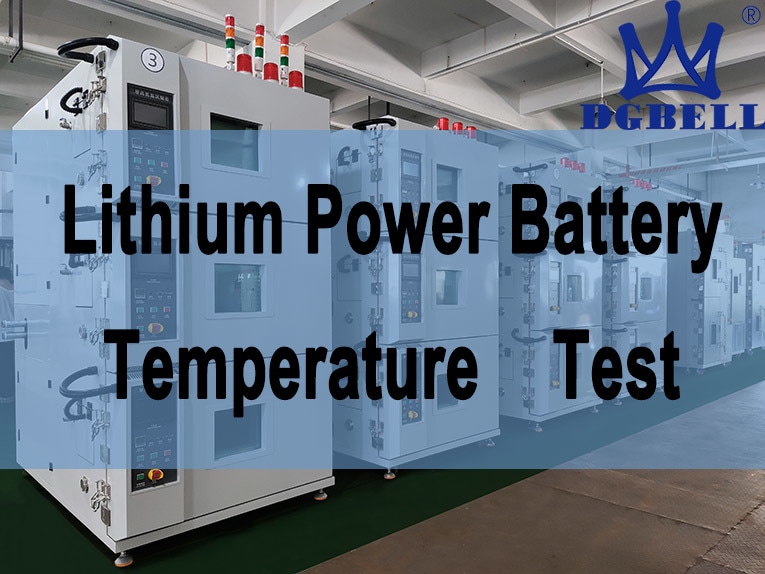
#Industry News
Lithium Power Battery Temperature Test
Lithium Power Battery Temperature Test
Lithium ion batteries have many advantages such as high specific energy, high specific power, and high voltage platform, and have good application prospects in energy storage and new energy electric vehicles. The cell structure of existing lithium-ion batteries can be divided into layered and wound structures. Compared with wound structures, stacked structures can increase battery capacity and reduce internal resistance. However, this arrangement method can easily lead to uneven temperature distribution along the plane direction of the battery during high rate discharge. In order to analyze the problem of uneven distribution of battery temperature, an accurate battery simulation model can be established to clarify the characteristics of temperature field distribution, in order to provide battery manufacturers with more information on optimizing battery structure.
It is common to use finite element method for simulation analysis of multiple physical fields in batteries. In modeling, researchers typically use a non layered lumped parameter model to analyze the temperature field distribution of batteries by coupling a one-dimensional model. Or ignore the temperature gradient along the thickness direction of the battery and only analyze the surface temperature distribution of the battery. In fact, lithium-ion batteries have a three-dimensional layered structure and different heat sources in different parts, which inevitably leads to uneven temperature distribution inside the battery. In order to predict the electrochemistry and temperature field distribution of each layer of lithium-ion batteries more accurately, this paper establishes a three-dimensional single-layer electrochemistry thermal coupling model based on multi physics field analysis software, and studies the characteristics and temperature field distribution of different parts of the battery on this basis. The research work in this article can provide theoretical basis for the structural optimization of lithium-ion batteries and the development of battery thermal management.
1 Thermal model
This article takes square stacked lithium-ion power batteries as the research object. The battery is composed of 60 electrode pairs stacked together, each consisting of five parts: positive electrode current collector, positive electrode active material, negative electrode active material, and negative electrode current collector. During the discharge process, the current flows through the negative electrode ear, passes through the diaphragm and positive and negative electrodes, and finally flows from the positive electrode ear. During this process, complex chemical and electrochemical reactions and material transport processes will be observed, leading to changes in the internal temperature field of the battery. In response to this phenomenon, this article establishes a three-dimensional electrochemical thermal coupling model by coupling mass, charge, energy conservation, and electrochemical kinetics. Studied the electrochemical and thermal characteristics of the battery during the discharge process.
2 Test
In the three-dimensional distribution model, we focus on the internal distribution characteristics of the electrochemical system, including potential distribution, SOC distribution, current density distribution, and lithium ion concentration distribution. Due to the difficulty in measuring the electrochemical distribution characteristics of batteries through experiments, this article verifies them by comparing the external electrochemical characteristics of batteries. The test platform mainly includes DGBELL high and low temperature chamber, charging and discharging cabinet, and multi physics field simulation software. Before the test, charge the battery to full charge with 1 C current and let it stand for 1 hour. Then, perform 1 C and 2 C constant current discharge on the battery, and record the voltage changes during the discharge process. After comparing the simulation and experimental results, it can be seen that the consistency between the experimental and simulation results is good, and the accuracy of the model has been verified.
2.1 Current density distribution
The current density distribution on the positive and negative current collectors of the battery at the end of 2 C discharge. During the discharge process, all current flows from the external circuit into the negative electrode ear and is distributed throughout the negative current collection area. As the distance from the negative electrode ear increases, the current density gradually decreases. This is because a portion of the current flowing into the pole ear flows perpendicular to the direction of the sandwich structure. The current flowing through the battery cell is called the local working current, which transfers the charges involved in the electrochemical reaction from the negative electrode to the positive electrode. During the operation of the battery, uneven distribution of local working current can lead to local overcharging or discharging, thereby affecting the safety and lifespan of the battery. Therefore, understanding this key parameter is extremely important.
During the discharge process, the reaction current density in the polar ear region changes from the maximum value to the minimum value. This may be because during the discharge beam, the lithium ions in the electrolyte in the polar ear region are almost depleted, thereby reducing the electrochemical reaction rate near the polar ear. At the end of discharge, there was a significant gradient in the reaction current density of the battery, which may be due to the large concentration polarization of the battery in the later stage of discharge, resulting in a significant gradient distribution of the reaction current density. However, during the discharge process, the gradient of the electrode reaction current density is not significant, indicating that the electrochemical reaction rate inside the electrode is basically stable.
2.2 Potential distribution
The uniformity of potential distribution affects the performance of batteries. The high local potential of the battery may lead to severe non-uniformity in the performance of the battery plates, reducing battery performance. During 2C discharge, the solid phase potential distribution of the anode and cathode indicates the existence of a significant voltage gradient distribution during the discharge process. During discharge, the current flows into the battery from the negative electrode and then flows out from the positive electrode. According to Ohm’s law, the potential decreases in the direction of the current. Therefore, the highest potential of the anode is located on the negative electrode ear, while the lowest potential of the cathode is located on the positive electrode ear. In addition, due to the accumulation of current flowing into or out of the battery at the electrode ears, the potential change in the connection area between the electrode ears and the electrode plate is very uneven, and the potential distribution in the remaining parts of the electrode plate is relatively uniform.
2.3 Temperature characteristic analysis
The discharge of lithium-ion batteries is a typical transient thermal conductivity process that sometimes varies from an internal heat source. Temperature field distribution of batteries with different discharge depths under 2 C discharge conditions. During the discharge process, the temperature of the battery continuously rises. However, the temperature rise rate of the battery is not the same at different positions. In the early stage of discharge, the temperature rise rate near the pole ear area is higher, while the temperature rise rate away from the pole ear area is lower.
As the discharge process deepens, the temperature rise rate away from the electrode ears increases, possibly due to the depletion of lithium ions at the electrode ears in the later stage of discharge, resulting in a decrease in the reaction current density in the electrode ear area and a decrease in the Ohmic heat generation rate. However, in the bottom area of the battery, due to the low flow consumption in the early stage of lithium ion discharge, the lithium ion content is relatively abundant in the later stage of discharge, and the number of lithium ions participating in the reaction significantly increases, resulting in an increase in the current density of the battery bottom reaction and an increase in the Ohmic heat generation rate in the later stage of discharge. During the discharge process, the reaction current density in the positive electrode region changed from the maximum value to the minimum value, further proving the simulation results.
3 conclusion
This article proposes a three-dimensional electrochemical coupling model by coupling mass, charge, energy, and electrochemical kinetic equations. Using this model, the spatiotemporal distribution of the thermal characteristics of stacked lithium-ion batteries was studied. The main conclusions are as follows:
(1) Accurately analyze the temperature field changes and heat generation characteristics of a three-dimensional electrochemical and three-dimensional thermally coupled cedar ion battery.
(2) By establishing a three-dimensional electrochemical thermal coupling model, traditional experimental methods can obtain results that are difficult to obtain, such as local potential distribution and current density distribution of batteries
(3) During the constant current discharge process, there is a significant temperature gradient inside the battery, especially in the transition zone between the ear and plate, where the temperature gradient changes the most.
(4) The temperature rise rate of the battery at different positions during the discharge process is not the same. In the early stage of discharge, the temperature rise rate in the polar ear area is the highest, while the temperature rise rate in the bottom area of the battery far from the polar ear is relatively small. However, there is an increasing trend in the later stage of discharge. The three-dimensional electrochemical thermal model established in this article provides an effective method for observing the internal electrochemical and thermal behavior of lithium-ion batteries, and has good application prospects in guiding the optimization design of lithium battery monomer structures







